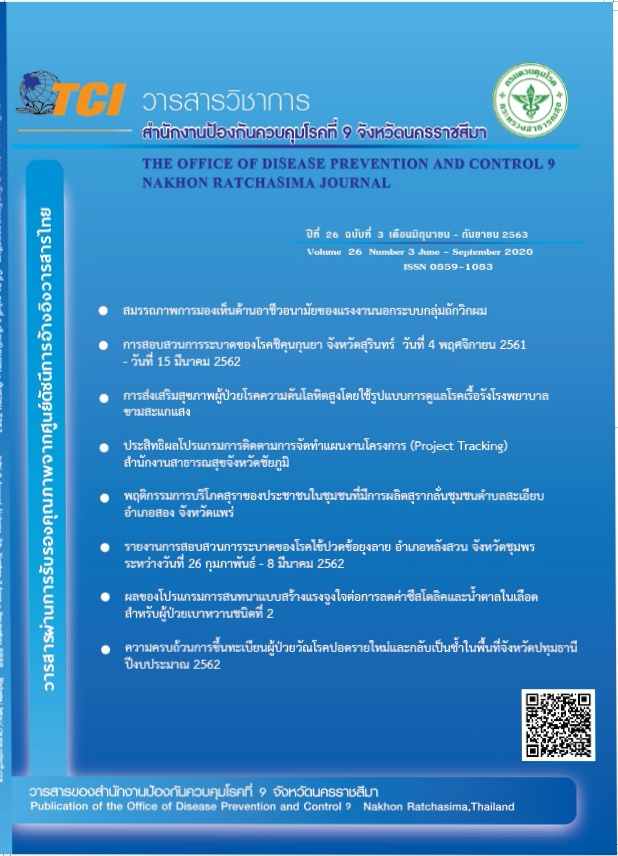Effectiveness the Project Tracking System, Chaiyaphum Provincial Health Office
Keywords:
System, ProjectAbstract
Creating a good project and getting approval to act quickly is important. The purpose of developing research was to develop a project tracking system of the Chaiyaphum Provincial Health Office. The research subjects consisted of 32 persons responsible for the project in the general hospital, community hospital, and district public health offices. System development life cycle (SDLC) to develop project tracking included 6 steps 1) Planning 2) Analysis 3) Design 4) Construction testing and publishing 5) Implementation 6) Maintenance and innovation. Then the satisfaction of the user was assessed. The data were analyzed by percentage, mean, and standard deviation. The result revealed that the participants consisted of males and females each 50%, age 46-55 years (46.70%), bachelor’s degree education (53.30%), public health officer (70%), and working in community hospitals (56.76%). The overall of satisfaction was the most satisfaction ( = 4.22, S.D.= 0.54), the efficiency and benefit were the most satisfaction ( = 4.31, S.D.= 0.51). The item that had the highest score was helping to faster work ( = 4.50, S.D.= 0.68) and reduce paper ( = 4.40, S.D.= 0.72). About 60% of the participants using the telephone for following the project before the implementation of the project tracking system. Paper use was reduced from 16 sheets to 8 sheets/project, and reduce the time from 36 days to 29 days/project after the project tracking system was conducted. The study recommends that the project tracking system should be applied for other work in the organization to
References
2. สำนักงานคณะกรรมการพัฒนาเศรษฐกิจและสังคมแห่งชาติ สำนักนายกรัฐมนตรี.แผนพัฒนาเศรษฐกิจและสังคมแห่งชาติ ฉบับที่ 12 พ.ศ.2560-2564.[ออนไลน์]2562.เข้าถึงเมื่อ20 ธันวาคม 2562. เข้าถึงได้จาก http://plan.bru.ac.th/wp-content/uploads/2018/
3. สำนักงานปลัดกระทรวงสาธารณสุข. คู่มือการจัดทำแผนปฏิบัติการ. [ออนไลน์] 2562 เข้าถึงเมื่อ 20ธันวาคม 2562. เข้าถึงได้จาก http://bps.moph.go.th/new_bps/sites/default/ files/ 3. guide_the_ministrys_action_plan54.pdf.
4. โอภาส เอี่ยมสิริวงศ์. คู่มือการพัฒนาและปรับปรุงระบบเทคโนโลยีสารสนเทศและการสื่อสาร.ประจำปีงบประมาณ พ.ศ. 2559. ศูนย์เทคโนโลยีสารสนเทศและการสื่อสารสำนักงานปลัดกระทรวงมหาดไทย.
5. สำนักงานมาตรฐานและประเมินผลอุดมศึกษา สำนักงานคณะกรรมการอุดมศึกษา. แบบประเมินความพึงพอใจเกี่ยวกับระบบ. [ออนไลน์] 2562 เข้าถึงเมื่อ 20 ธันวาคม 2562.เข้าถึงได้จากhttp://www.cheqa.mua.go.th/cheplus/che_questionaire54.doc.
6. กุสุมา เลาะเด. การประเมินผลการใช้งานโปรแกรมเรียนรู้ภาษาอังกฤษด้วยตนเอง “ SPEEXX”: กรณีศึกษามหาวิทยาลัยราชภัฏวไลยอลงกรณ์ในพระบรมราชูปภัมภ์. วารสารวไลอลงกรณ์ปริทัศน์ (มนุษยศาสตร์และสังคมศาสตร์). 2560; 7(2): 83-95.
7. ยุทธ สุขสงัด. ความพึงพอใจการใช้งานโปรแกรม ไมโครซอฟท์ เอาท์ลุค ของพนักงานแผนกสายบัตรเครดิต ธนาคารกรุงเทพจำกัด(มหาชน) สำนักงานใหญ่. วารสารวิจัย มทร. 2560; 11(2); 78-92.
8. นารีรัตน์ ทรงทิพย์. ความพึงพอใจของพนักงานระดับปฏิบัติการในการใช้ระบบข้อมูลจากจุดขาย(PSO) ในการดำเนินงานด้านการกระจายสินค้า(Logistic)ของเซเว่นอีเลเว่นในเขตกรุงเทพมหานคร.[วิทยานิพนธ์บัณฑิตวิทยาลัย] กรุงเทพ: สถาบันเทคโนโลยีพระจอมเกล้า เจ้าคุณทหารลาดกระบัง; 2547.
9. ปภัสสร ธนวิโรจน์กุล. ประสิทธิผลของโปรแกรมคอมพิวเตอร์สำหรับบันทึกการพยาบาลผ่าตัด. วารสารพยาบาลศาสตร์ จุฬาลงกรณ์มหาวิทยาลัย. 2553; 22(พิเศษ2): 144-154.
10. นรเทพ ศักดิ์เพชร, แก้ว นวลฉวี, สุพรรณ กาญจนสุธรรม และณรงค์ พลีรักษ์. ความพึงพอใจของผู้ใช้งานโปรแกรมประยุกต์บนเว็บเชิงพื้นที่เพื่อเตือนภัยน้ำท่วมเมืองหาดใหญ่. วารสารวิชาการสาขาวิทยาศาสตร์และเทคโนโลยี(เพื่อการพัฒนาท้องถิ่น) มหาวิทยาลัยราชภัฏอุตรดิตถ์ 2559; 11(2): 103 - 116.

Downloads
Published
How to Cite
Issue
Section
License
บทความที่ลงพิมพ์ในวารสารวิชาการสำนักงานป้องกันควบคุมโรคที่ 9 จังหวัดนครราชสีมา ถือว่าเป็น
ลิขสิทธิ์ สำนักงานป้องกันควบคุมโรคที่ 9 จังหวัดนครราชสีมา



